A Study on the Dynamic Strength Deterioration Mechanism of Frozen Red Sandstone at Low Temperatures
Abstract
:1. Introduction
2. Dynamic Impact Test of Frozen Red Sandstone
2.1. Specimen Preparation and Corresponding Parameters
2.2. Experimental Scheme
3. Temperature Effect on Mechanical Properties of Red Sandstone under High Strain Rate
3.1. Analysis of Dynamic Mechanical Properties
3.2. Influence of Negative Temperature on Damage Variables
3.3. Macroscopic Failure Pattern of Red Sandstone at Negative Temperatures
4. Analysis of Mesoscopic Fracture Morphology
5. Discussion
5.1. Influence of Water-Ice Phase Transformation on Dynamic Strength of Red Sandstone
5.2. Fracture Mode of Frozen Red Sandstone
6. Conclusions
- (1)
- A change in negative temperature significantly affects the dynamic mechanical properties of red sandstone, which is equivalent to applying precompression stress to red sandstone. Although the rock tends to be brittle as a whole, its ability to resist tensile stress is enhanced. Therefore, within the range from 25 °C to −30 °C, its dynamic compressive strength increases gradually with a decrease in temperature.
- (2)
- Lower negative temperatures lead to “frostbite” and deterioration of dynamic mechanical properties of red sandstone under high strain rate loading. The test results show that the dynamic compressive strength of red sandstone decreases sharply after −30 °C, which is different from the results obtained in static or quasi-static tests at −30 °C.
- (3)
- At high strain rates, the fracture degree of red sandstone gradually intensifies with a decrease in negative temperature (from −5 to −40 °C), and the failure mode of the stone gradually transitions from the initial negative temperature tension failure to the slip shear failure at a lower negative temperature, which is consistent with the transformation of the internal structural fracture mode at the mesoscopic level.
Author Contributions
Funding
Data Availability Statement
Acknowledgments
Conflicts of Interest
References
- Liu, Q.S.; Huang, S.B.; Kang, Y.S.; Cui, X. Advance and review on freezing-thawing damage of fractured rock. Chin. J. Rock Mech. Eng. 2015, 34, 452–471. [Google Scholar]
- Chen, W.Z.; Tan, X.J.; Yu, H.D.; Yuan, K.; Li, S. Advance and review on thermo-hydro-mechanical characteristics of rock mass under condition of low temperature and freeze-thaw cycles. Chin. J. Rock Mech. Eng. 2011, 30, 1318–1336. [Google Scholar]
- Aoki, K.; Hibiya, K.; Yoshida, T. Storage of refrigerated liquefied gases in rock caverns: Characteristics of rock under very low temperatures. Tunnell. Undergr. Space Technol. 1990, 5, 319–325. [Google Scholar] [CrossRef]
- Yamabe, T.; Neaupane, K.M. Determination of some thermo-mechanical properties of Sirahama sandstone under subzero temperature condition. Int. J. Rock Mech. Min. Sci. 2001, 38, 1029–1034. [Google Scholar] [CrossRef]
- Dwivedi, R.D.; Soni, A.K.; Goel, R.K.; Dube, A.K. Fracture toughness of rocks under sub-zero temperature conditions. Int. J. Rock Mech. Min. Sci. 2000, 37, 1267–1275. [Google Scholar] [CrossRef]
- Tang, M.M.; Wang, Z.Y.; Sun, Y.L.; Ba, J. Experimental study of mechanical properties of granite under low temperature. Chin. J. Rock Mech. Eng. 2010, 29, 787–794. [Google Scholar]
- Xi, J.M.; Yang, G.S.; Pang, L.; Lv, X.-T.; Liu, F.-L. Experimental study on basic mechanical behaviors of sandy mudstone under low freezing temperature. J. China Coal Soc. 2014, 39, 1262–1268. [Google Scholar]
- Xu, G.M.; Liu, Q.S.; Peng, W.W.; Chang, X.X. Experimental study on basic mechanical behaviors of rocks under low temperatures. Chin. J. Rock Mech. Eng. 2006, 25, 2502–2508. [Google Scholar]
- Yang, G.S.; Lv, X.T. Experimental study on the sandy mudstone mechanical properties of shaft sidewalls under the frozen conditions. J. Min. Saf. Eng. 2012, 29, 492–496. [Google Scholar]
- Yang, G.S.; Xi, J.M.; Li, H.J.; Cheng, L.; Lv, X. Experimental study on the mechanical properties of soft rock of coal mine shaft sidewalls under the frozen conditions. Chin. J. Undergr. Space Eng. 2012, 8, 690–697. [Google Scholar]
- Lei, W.; Zhi, J.W.; Abbas, T.; Quansheng, L.; Huai, L. Deterioration of dynamic mechanical properties of granite due to freeze-thaw weathering: Considering the effects of moisture conditions. Cold Reg. Sci. Technol. 2020, 176, 103092. [Google Scholar]
- Ke, B.; Zhou, K.; Xu, C.; Hongwei, D.; Li, J.; Bin, F. Dynamic mechanical property deterioration model of sandstone caused by freeze-thaw weathering. Rock Mech. Rock Eng. 2018, 51, 2791–2804. [Google Scholar] [CrossRef]
- Shan, R.L.; Yang, H.; Zhang, J.X.; Guo, Z.; Dinghong, Z. Mechanical properties of saturated red sandstone of Meilinmiao mine under loading and unloading at negative temperatures. J. Min. Saf. Eng. 2016, 33, 924–931. [Google Scholar]
- Shan, R.L.; Yang, H.; Guo, Z.M.; Liu, X.; Song, L. Experimental study of strength characters of saturated red sandstone on negative temperature under triaxial compression. Chin. J. Rock Mech. Eng. 2014, 33, 3657–3664. [Google Scholar]
- Shan, R.L.; Zhang, L.; Yang, H.; Zhang, j.X.; Guo, Z.M. Experimental study of freeze-thaw properties of saturated red sandstone. J. China Univ. Min. Technol. 2016, 45, 923–929. [Google Scholar]
- Li, H.J. Experimental Study on Rock Mechanical Properties under Freezing Conditions. Ph.D. Thesis, Xi’an University of Science and Technology, Xi’an, China, 2009. [Google Scholar]
- Cheng, L. Experimental Study on Rock Mechanical Properties under Freezing Conditions and Application in Project. Ph.D. Thesis, Xi’an University of Science and Technology, Xi’an, China, 2009. [Google Scholar]
- Xi, J.M.; Yang, G.S.; Dong, X.H. Effect of freezing temperature on mechanical properties of sandy mudstone. J. Chang’an Univ. (Nat. Sci. Ed.) 2014, 34, 92–97. [Google Scholar]
- Li, Y.P.; Wang, Z.Y. Uniaxial compressive mechanical properties of rock at low temperature. J. Univ. Sci. Technol. Beijing 2011, 33, 671–675. [Google Scholar]
- Xu, J.Y.; Fan, J.S.; Lü X, C. Dynamic Mechanical Properties of Rock with the Confining Pressure; Northwestern Polytechnical University Press: Xi’an, China, 2012. [Google Scholar]
- Xie, H.P.; Gao, F.; Zhou, H.W.; Zuo, J.P. Fractal fracture and fragmentation in rocks. J. Disasaster Prev. Mitig. Eng. 2003, 23, 1–9. [Google Scholar]
- Qian, Y. Experimental Study on Blasting Fragment-Size of Joints Rock Mass based on Fractal Theory. Ph.D. Thesis, Wuhan University of Technology, Wuhan, China, 2005. [Google Scholar]
- Wen, M.; Xu, J.Y.; Wang, H.Y.; Fang, X.Y.; Zheng, G.H. Fractography analysis of sandstone failure under low temperature-dynamic loading coupling effects. Chin. J. Rock Mech. Eng. 2017, 36, 3822–3830. [Google Scholar]
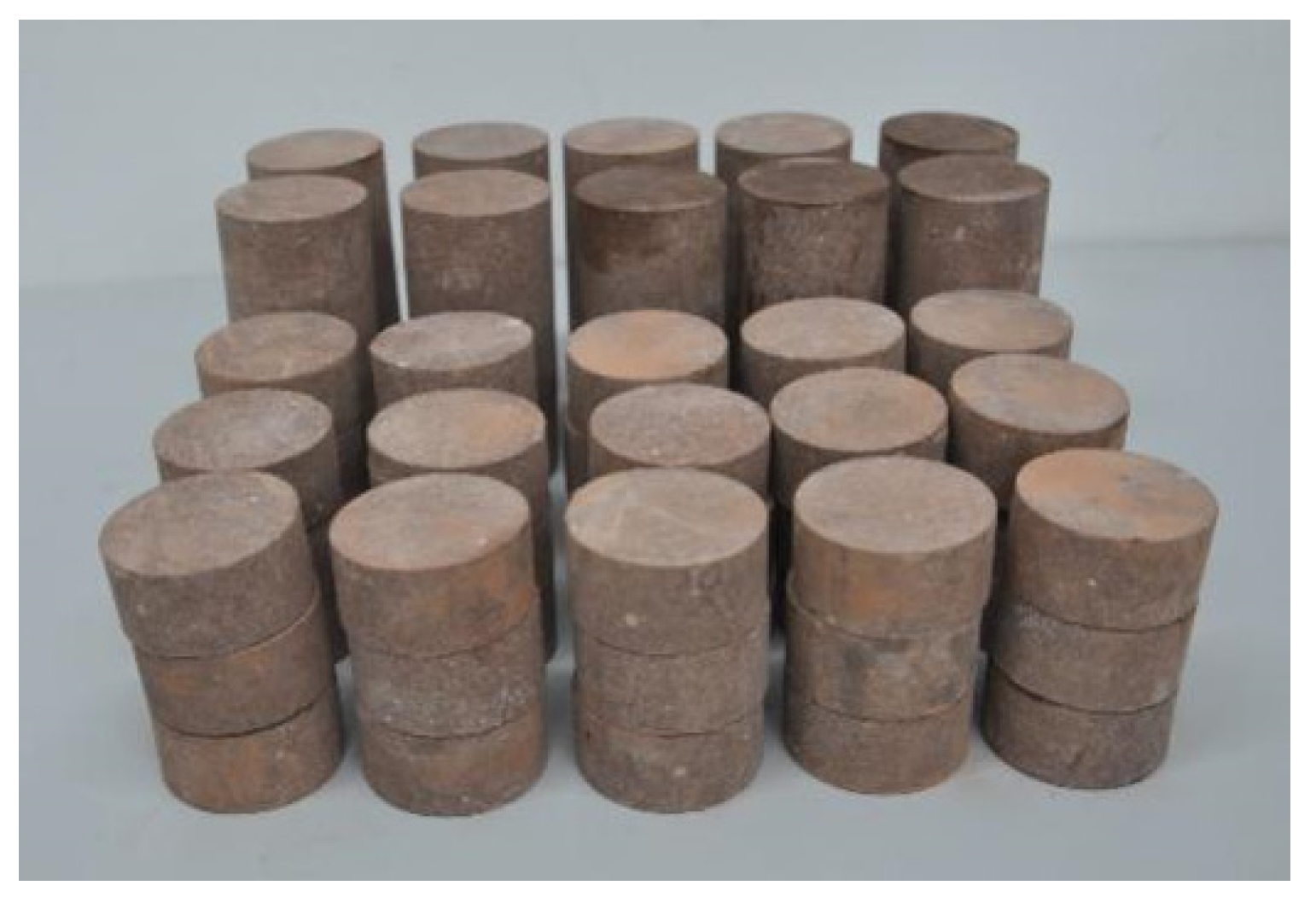
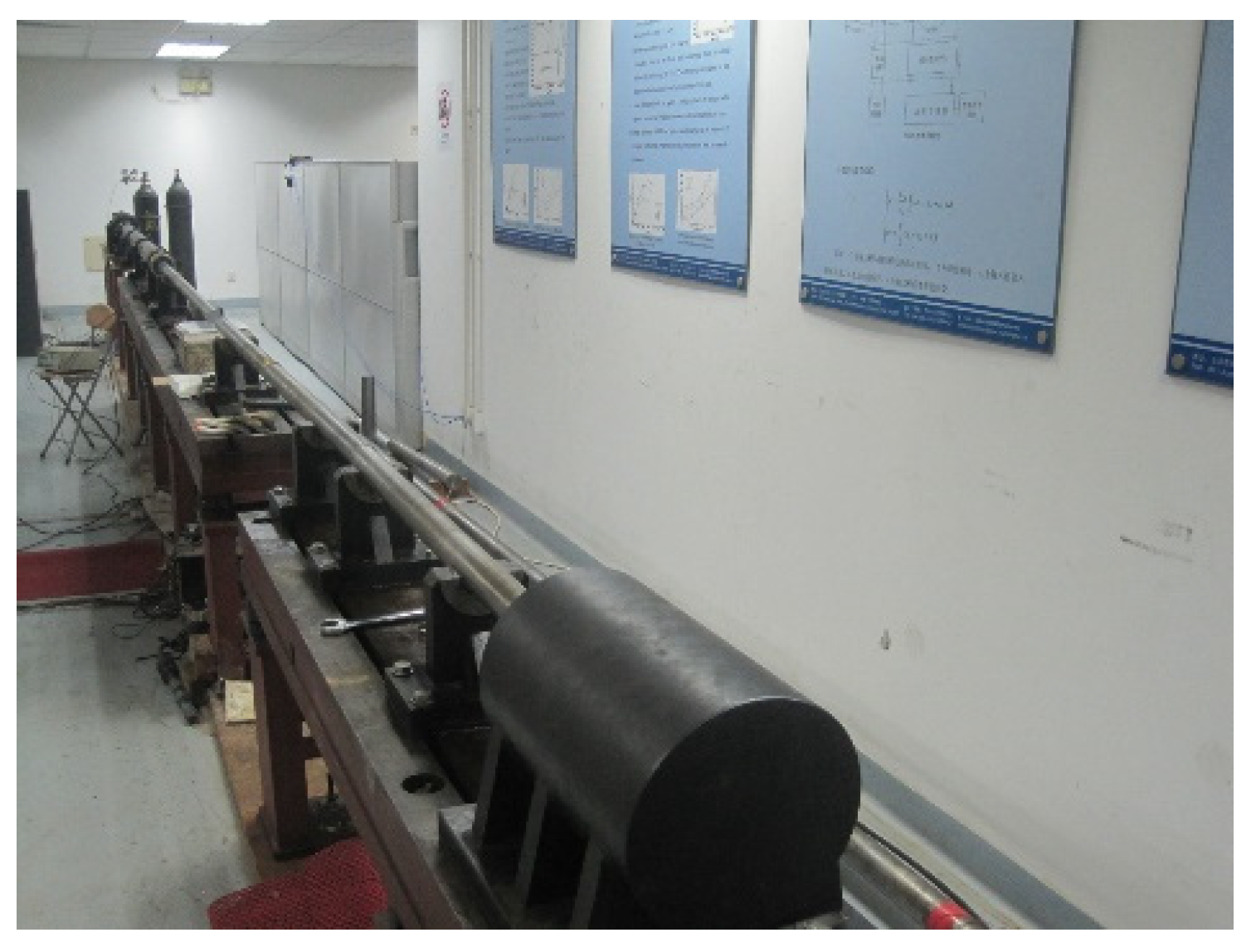
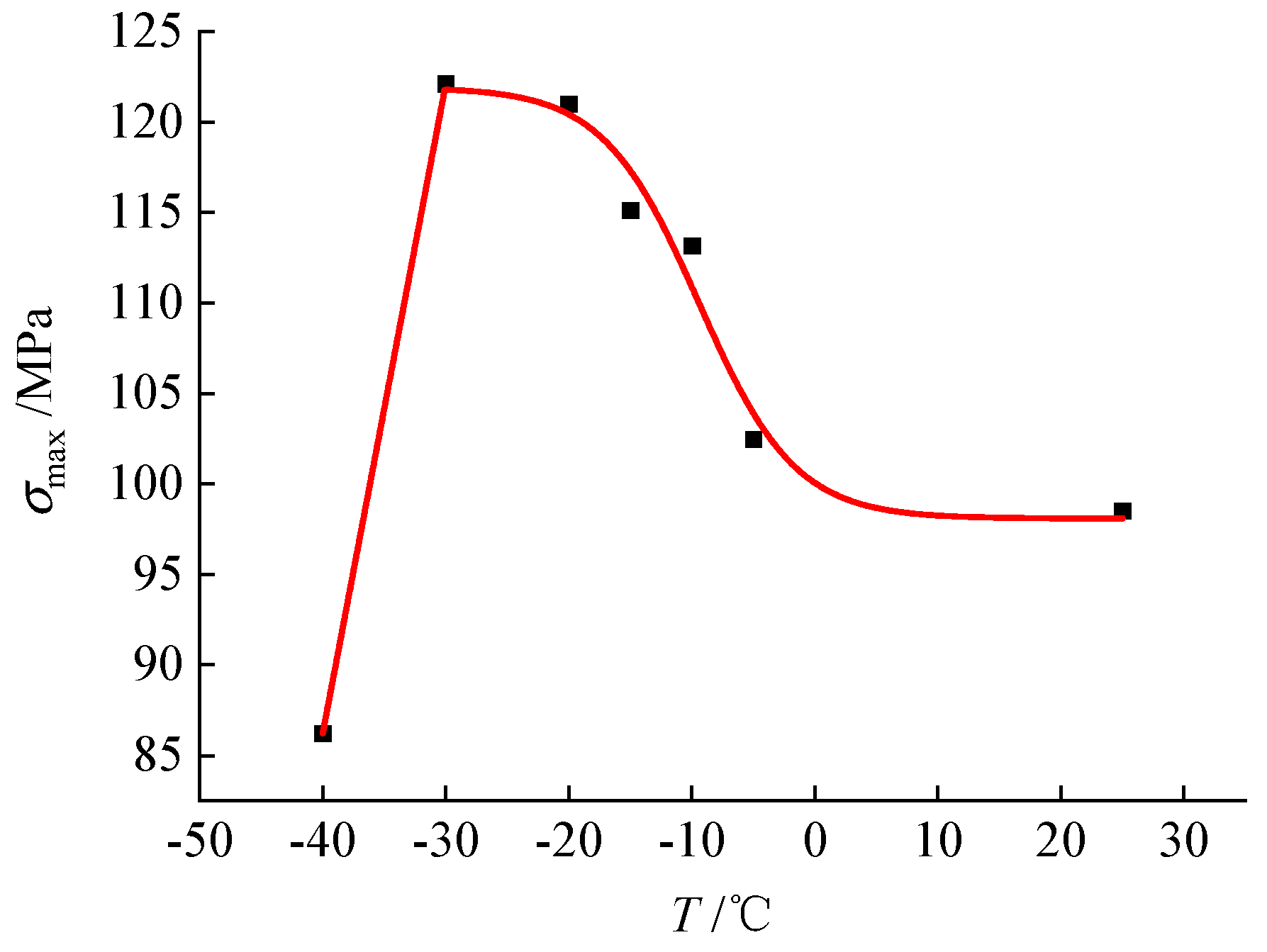

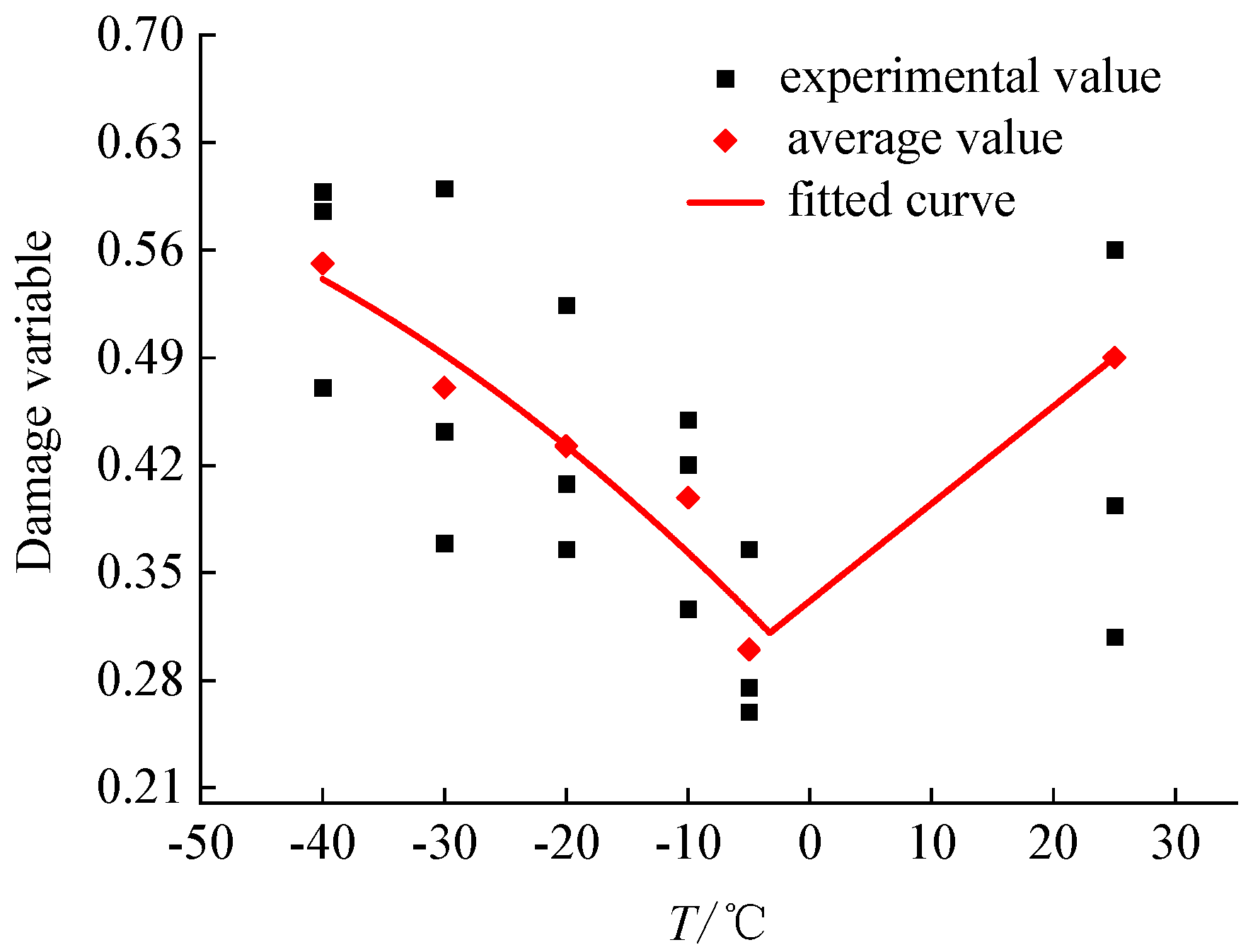

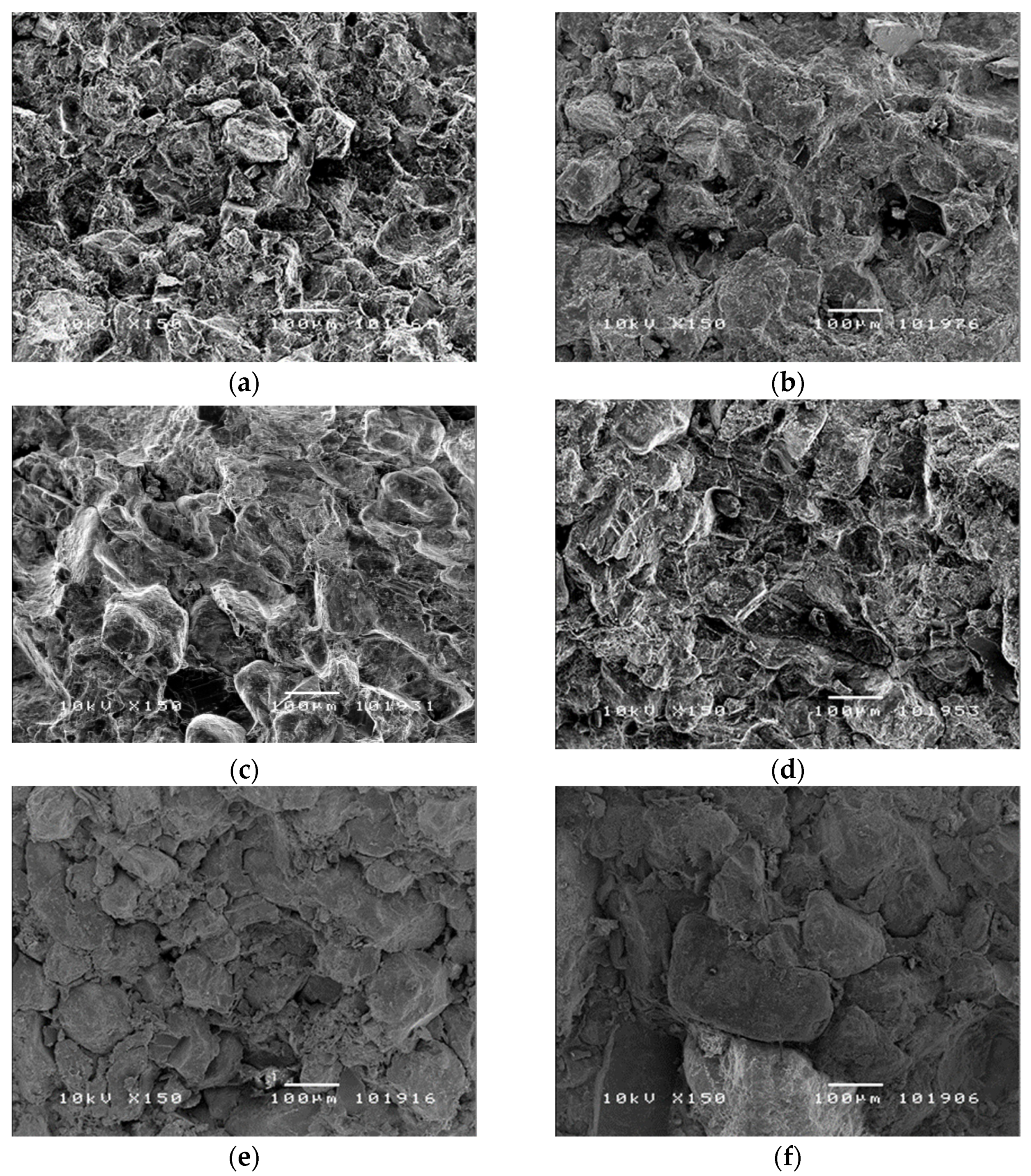
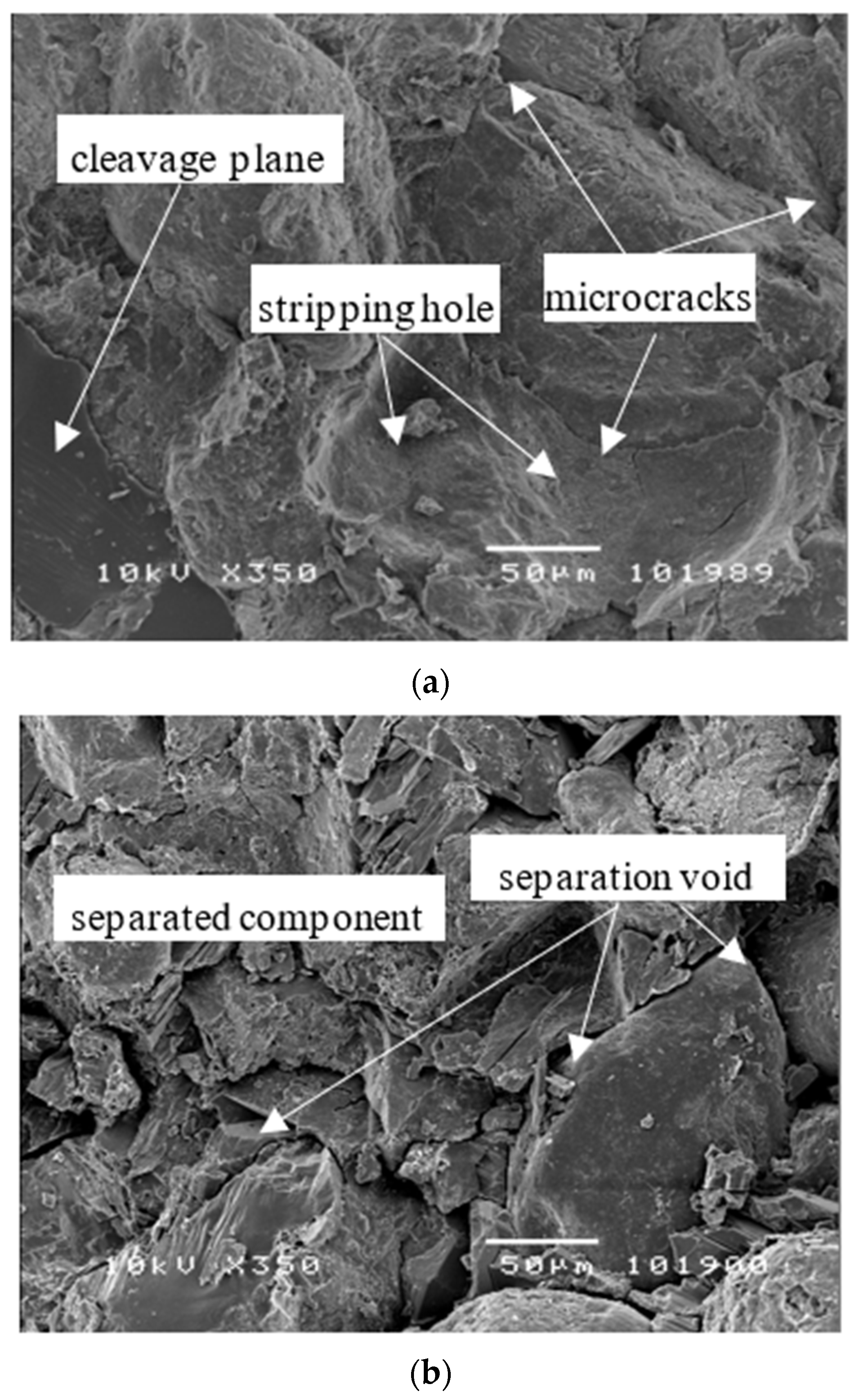

| Rock Type | Velocity of Longitudinal Wave m·s−1 | Dry Density kg·m−3 | Saturated Density kg·m−3 | Saturation Rate % | |
|---|---|---|---|---|---|
| Dry | Saturated | ||||
| Red sandstone | 2780 | 3651 | 2292 | 2371 | 3.46 |
| Serial Number | T °C | U J·m−3 | wd J·m−3 | d | |
|---|---|---|---|---|---|
| Experimental Value | Average Value | ||||
| 1 | 25 | 2,026,020 | 798,014.6 | 0.39 | 0.42 |
| 2 | 1,824,890 | 1,022,309.0 | 0.56 | ||
| 3 | 2,170,870 | 669,018.2 | 0.31 | ||
| 4 | −5 | 2,308,220 | 635,319.7 | 0.28 | 0.30 |
| 5 | 2,309,290 | 599,024.3 | 0.26 | ||
| 6 | 2,036,210 | 744,266.1 | 0.37 | ||
| 7 | −10 | 1,843,130 | 774,945.0 | 0.42 | 0.40 |
| 8 | 1,829,330 | 597,333.3 | 0.33 | ||
| 9 | 1,554,370 | 698,912.0 | 0.45 | ||
| 10 | −20 | 1,803,090 | 945,189.0 | 0.52 | 0.43 |
| 11 | 2,121,560 | 775,307.4 | 0.37 | ||
| 12 | 2,225,180 | 907,565.0 | 0.41 | ||
| 13 | −30 | 2,046,070 | 904,847.4 | 0.44 | 0.47 |
| 14 | 2,196,160 | 810,938.4 | 0.37 | ||
| 15 | 1,944,590 | 1,167,188.0 | 0.60 | ||
| 16 | −40 | 2,000,980 | 941,746.6 | 0.47 | 0.55 |
| 17 | 1,754,530 | 1,049,546.0 | 0.60 | ||
| 18 | 1,658,340 | 970,915.8 | 0.59 | ||
| T | −5 °C | −10~−30 °C | −40 °C |
|---|---|---|---|
| Characteristics of macroscopic failure | Damage mode is given priority with the tension damage. The shape of broken body is mainly the columnar splitting structure. | The failure mode changes from tensile failure to shear failure. The number of columnar splitting structures decrease, while the number of lamellar spallation structures increase. | Shear failure is the main failure mode, and the shape of the broken body is mainly the lamellar and conical structure. |
| Change law of dynamic strength | Gradually Increasing | Dramatically reducing | |
| Cause analysis | The water-ice phase transformation occurs, the bond between mineral particles increases, the rock integrity is enhanced, and the dynamic strength is improved. Sandstone with enhanced brittleness and integrity is more prone to tensile failure along the loading direction under impact load. | With a decrease in negative temperature, the red sandstone shrinks as a whole, and the interlacing between mineral particles and solid ice becomes closer, and the dynamic mechanical strength increases significantly. The resistance of rock to radial contraction is further reduced, and the rock fracture is lamellar structure under the action of reverse tensile wave. | The shrinkage rate and amplitude of each component material in sandstone are quite different when it is cooled. A large number of cracks are formed at the contact of the components, and the plastic deformation ability at the crack tip is poor. Low stress brittle failure occurs easily under negative temperature and high strain rate loading, and the strength drops sharply. |
| T °C | Fracture Mode | Dynamic Strength MPa | Dissipated Energy WL J |
|---|---|---|---|
| 25 | Cement fracture, intergranular fracture | 98.51 | 147.63 |
| −5 | Cement fracture | 102.47 | 109.10 |
| −10 | Cement fracture | 113.16 | 131.63 |
| −20 | Cement fracture | 121.01 | 145.05 |
| −30 | Cement fracture, intergranular fracture | 122.12 | 158.78 |
| −40 | Cement fracture, transgranular fracture | 86.23 | 169.13 |
Publisher’s Note: MDPI stays neutral with regard to jurisdictional claims in published maps and institutional affiliations. |
© 2021 by the authors. Licensee MDPI, Basel, Switzerland. This article is an open access article distributed under the terms and conditions of the Creative Commons Attribution (CC BY) license (https://creativecommons.org/licenses/by/4.0/).
Share and Cite
Yang, Y.; Zhang, N.; Wang, J. A Study on the Dynamic Strength Deterioration Mechanism of Frozen Red Sandstone at Low Temperatures. Minerals 2021, 11, 1300. https://doi.org/10.3390/min11121300
Yang Y, Zhang N, Wang J. A Study on the Dynamic Strength Deterioration Mechanism of Frozen Red Sandstone at Low Temperatures. Minerals. 2021; 11(12):1300. https://doi.org/10.3390/min11121300
Chicago/Turabian StyleYang, Yang, Niannian Zhang, and Jianguo Wang. 2021. "A Study on the Dynamic Strength Deterioration Mechanism of Frozen Red Sandstone at Low Temperatures" Minerals 11, no. 12: 1300. https://doi.org/10.3390/min11121300
APA StyleYang, Y., Zhang, N., & Wang, J. (2021). A Study on the Dynamic Strength Deterioration Mechanism of Frozen Red Sandstone at Low Temperatures. Minerals, 11(12), 1300. https://doi.org/10.3390/min11121300







